
PO Box 9021, Wilmington, DE 19809, USA
E-mail: tours@focusonnature.com
Phone: Toll-free in USA, Canada, & Puerto Rico 1-800-721-9986
or 302/529-1876

PO Box 9021, Wilmington, DE 19809, USA
E-mail: tours@focusonnature.com
Phone: Toll-free in USA, Canada, & Puerto Rico 1-800-721-9986
or 302/529-1876
Focus
On Nature Tours
News
in
our
e-news bulletins
noting tours in Arizona,
Brazil, Colorado, Costa Rica,
Japan, Mexico, Texas
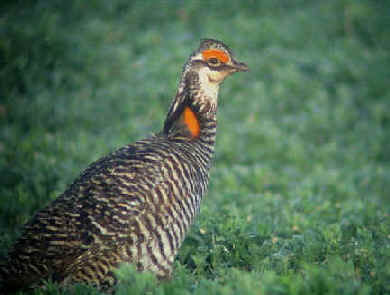
The
GREATER PRAIRIE CHICKEN
was seen during a FONT tour in Nebraska in April 2010.
A PHOTO GALLERY of BIRDS during the FONT tour in Brazil & Uruguay in October 2010
FONT E-NEWS, September 2010: Our back-to-back tours in ARIZONA & SONORA in MEXICO
FONT
E-NEWS, June 2010: To JAPAN where both Birds & People Traveled Afar
also: some new bird taxonomy & nomenclature & notes regarding the Crested Ibis
FONT E-NEWS, May 2010: in TEXAS, a Reunion & Tour
Highlights
FONT E-NEWS, April
2010: in COLORADO, NEBRASKA, & WYOMING for Grouse &
More
FONT E-NEWS, March 2010: 400 species of birds in northern & southern COSTA RICA
FONT
E-NEWS, February 2010: in the Amazon region, our 47th tour in BRAZIL
FONT E-NEWS, January 2010: our 33rd birding & nature tour in
JAPAN
Earlier FONT E-MAIL Bulletins in 2009
The above link to E-News relating to FONT tours conducted in: Brazil, the Canary Islands, Chile, Iceland, Japan, Spain.
A Chronological List of Upcoming FONT Birding & Nature Tours
Narratives & Photo Galleries relating to Past FONT Tours
![]()
FONT E-News, Volume 20, Number 6
June 2010
from Focus On Nature Tours
including:
Our May 2010 tour in Japan, where both birds and those who watched &
photographed them came from afar
Japan
- May 2010
Our spring tour in Japan
in May 2010 was the 34th FONT tour in
that country, and the 7th to include Hegura,
a small island in the Sea of Japan that is
an outstanding place for bird migration in the spring - one of the best such
places anywhere in the world.
Other places that were visited on the main Japanese island of Honshu included
the Japan Alps, the rural Noto
Peninsula, and forested hills in central
Honshu, and reed beds and rice fields in the eastern part of the
island.
Links:
More about the FONT Japan Tour in May 2010
Birds & Other Wildlife during our Japan Spring Tour - May 2010
Cumulative List of Birds during our Japan Tours (with some photos)
Birds during FONT tours on Hegura Island (with some photos)
Upcoming
FONT Birding & Nature Tours in Japan
![]()
FONT E-News, Volume 20, No. 5
May 2010
from Focus On Nature Tours, Inc.
including:
Texas - May 2010
Late last spring (in 2009), we did
a most interesting and enjoyable birding & nature tour in Iceland, a
fascinating place in the world for such a trip. A land, it is often said, of
fire and ice. The participants on the tour were a group, of about 20, from
mostly south-central Texas.
This spring, with volcanic activity, Iceland has been all the more fascinating, with even more fire!
Also this spring, at the end of our FONT birding & nature tour in Texas, a number of us who were on last year's Iceland tour had the opportunity to get together, not far from Austin, in the community of Wimberley. It was a very nice reunion, and a good get-together after we had first met a year ago on a tour in a distant land.
I just noted that there were about 20 participants on the late-spring 2009 tour in Iceland.
Having that many people is not the case normally with FONT tours in our program, and in our web-site: www.focusonnature.com which have a maximum of 5 or 6 participants, and are thus an optimum size for birding and nature observation.
It has only been our charter tours, over the years, with as many as 20 or so people that have been for groups such as the Wimberley, Texas Bird Society, and others including the Birmingham, Alabama and Venice, Florida Audubon Societies.
In the 20 years of FONT tours to various places in the world, there have been over 2,000 tour participants, and a high percentage of them have traveled with us as repeat customers. These people have been from nearly all of the US states (47 out of 50), and most of the Canadian provinces.
From nearly 20 other countries around the world, there have been FONT tour participants, including people from Australia, Japan, Thailand, Mexico, England, France, Germany, the Netherlands, Finland, and Norway.
During our tour in Texas this spring, having a tour participant from Norway was a reminder to those of us from the US of the beauty of such birds as the Northern Cardinal and Blue Jay, which can often times be taken for granted.
The largest of the 48 contiguous states, Texas is a land of superlatives. And for birding that is especially true. Texas has the most bird species of any US state, with over 630. New additions have been added just about annually, mostly vagrants from Mexico.
Texas is so much a place for birding that in the early days of the Peterson Bird Field Guides, there was the guide to the East, the guide to the West, and the guide to Texas. That was due in part to East meeting West in Texas (more will be noted about that later in this narrative), but there was certainly enough bird-wise in the state to fill the book!
In Texas, during our May 2010
tour, it was not just the number of species, but the large numbers of some of
the birds that was at times so noticeable. There were so many birds.
The state bird, the Mockingbird, was heard singing, again & again
& again.
Cardinals seemed to be everywhere, both seen and heard in many of the
habitats that we visited.
And more than once, when we stopped, we couldn't help but notice how many Dickcissels
were calling in the fields. So many.
Not only were there large numbers of birds, also there were tremendously large numbers of butterflies. And it seemed that wildflowers could not have been more plentiful. There were so many in bloom, and a variety.
In one woods that we visited, there were thousands and thousands of caterpillars. They were falling to the ground off trees, big and small. Many of the trees in that riparian woods were denuded, with trees, big and small, leafless. The caterpillars were "everywhere" on the ground.
As to the plethora of wildflowers and butterflies, we were told that earlier in the spring, before our tour, there had been a good spell of rain, after a long spell of drought, about 3 years. Other than the one denuded forest, there was greenery as we traveled about, along with the multi-colored fields of so many flowers.
Also in a very large number,
during our May '09 Texas Tour, in addition to the flowers, butterflies, and
birds, there was a mammal.
At dusk, at two locations, literally millions of Mexican Free-tailed Bats
were seen, flying out into the evening sky. They were in incredible swarms.
I noted that Texas has more bird species than any other state. It also has more bat species. Of the 45 species of bats in North America, 32 occur in Texas. And as to the number of individual bats, no other state comes close! As there are a number of places in Texas was "incredible swarms" of the Mexican Free-tailed Bats. And what's also "incredible" about them is that spread out during the night, high in the sky, over much of the expansive land called Texas.
Yes, Texas is a land of superlatives. And it is a great place for a birding and nature tour, as we did for about a week in early May 2010.
From the Gulf Coast west, there's an array of various habitats in Texas. These include pine and hardwood forests, prairies, deserts, hills and mountains, lakes and ponds, and farm and ranch lands. Such diversity assures the big variety of birds that occur in Texas.
During our May 2010 tour,
we did not cover Texas from one end to the other, but rather we concentrated in
south-central Texas, from the Gulf Coast west to the "Hill
Country" of the Edwards Plateau. In just that one region of the
state, there were nearly all of the habitats just noted (except for
mountains).
And in that region of south-central Texas, especially near the city of Austin,
for us, and our birding, East did meet West.
From that city east, birds included: Ruby-throated Hummingbird, Blue Jay, and
Red-bellied Woodpecker.
From that city west, birds included: Black-chinned Hummingbird, Western
Scrub Jay, and Golden-fronted Woodpecker.
And to the west and north of Austin, 2 of the truly avian stars of the Texas show occur: the Golden-cheeked Warbler and the Black-capped Vireo, with the warbler nesting nowhere else in the world other than in Texas, and the vireo nearly so.
About an hour east of Austin, we visited a pine forest that's about 200 miles west of any other such habitat. For that reason, the place is called the "Lost Pines". Whether or not lost, the place is good to find. In it, we encountered nesting Pine Warblers, Northern Parulas, singing Summer Tanagers and Carolina Wrens, much as one would hear somewhere in the pines of the Southeast US. After dark, Chuck-will's-widows called, much as they would in a Southeast US pine forest.
Along the Gulf Coast, a nice call we heard, late in the day, was that of the Black Rail. It may have wintered in that marshy area, or it may have been passing through on its way to nest further north.
Numerous birds migrate north along the Texas seacoast in the spring. We enjoyed, as have in the past, such birds during their journey as warblers, flycatchers, and orioles. The Blackburnian and Black-throated Green Warblers were especially nice to see. An Olive-sided Flycatcher was a good find. And one small tree was filled with both colorful Baltimore and Orchard Orioles.
All of those birds would continue north. But some birds that we liked to see had migrated to Texas from their winter haunts.
Particularly notable among them were the many Scissor-tailed Flycatchers we saw. But no matter how many of them we saw, they continued to be good to see - every time.
And there were the numerous Dickcissels. Maybe some of them were to continue north, but others certainly seemed ready to stay, as males were constantly proclaiming their territories.
Onomatopoetically speaking,
there were not only the Dickcissels. Also there were the Northern
Bobwhite, the Eastern Wood Pewee, and the Killdeer.
They were "onomatopoetically speaking" as they all were saying their
names. At one time, all 4 of those species, were heard at once.
At other times, other onomatopoetic birds that we heard were the Eastern
Phoebe, the Pauraque, and the already-mentioned Chuck-will's-widow.
Along the Texas Gulf Coast, we
had a good day with many coastal birds, including numerous shorebirds,
long-legged waders, and a half-dozen species of terns and skimmers
at once.
Among the long-legged waders, the Reddish Egrets were particularly worth
watching for a while. We observed both the dark and white morphs of that species
doing their acrobatic antics as they danced about.
Among the shorebirds, we saw a bird that's rare in Texas, the Piping Plover.
The total North American population of that species is low, around 5,000 or so.
Along the Texas coast, there are not many to see, as we did.
A bird that is not rare in Texas
is the Cave Swallow. Not that many years ago, it was said to be in the
state in low numbers, mostly in limestone caves.
Now, the species is far from rare in Texas. It is abundant, notably at highway
overpasses, or closer to the ground at culverts by, for example, farm ponds. We
saw many Cave Swallows during our tour, although the similar Cliff
Swallow, of which we also saw many, is still said to be the most abundant
nesting swallow in Texas.
It's interesting that now, more than previously, after the breeding season,
numbers of Cave Swallows, of the race nesting in Texas, are being found
in the late fall further north in the US, especially in the northeast states.
As just noted, the Cave
and Cliff Swallows are much alike. Other birds that could be referred to
as "similar sibling species" were also noted during our spring '09
Texas tour, such as:
Glossy and White-faced Ibises, Long-billed and Short-billed
Dowitchers, and Boat-tailed and Great-tailed Grackles.
The Boat-tailed Grackle was only seen once, during the tour, along the
Gulf Coast.
The Great-tailed Grackle is yet another species of bird that is
ubiquitous in the state of Texas, where birds overall would be plentiful even
without the grackles - but of course, and especially in the cities and towns,
they do add measurably to the total number!
Bird-wise, we'll end with a
species that's not plentiful in Texas, but's now more common there, as it is
more common now elsewhere in North America than it was a couple decades ago, the
Bald Eagle.
One morning, as we were driving along a highway near the coast, an adult Bald
Eagle nicely sat for us itself atop a pole.
On the other side of the highway, there was a Northern Crested Caracara,
a bird sometimes referred to as the "Mexican Eagle".
Actually, by the way, it is the more-westerly Golden Eagle that is the
national bird of Mexico, as the Bald Eagle is the national bird of the
United States.
Among the mammals and other
wildlife during the FONT Texas May '10 Tour, in addition to the Mexican
Free-tailed Bats already mentioned, there were: Gray Fox, deer, raccoon,
opossum, and American Alligator and various turtles and
snakes.
![]()
FONT E-News, Volume 20, No. 4
April 2010
from Focus On Nature Tours, Inc.
Colorado, Nebraska, & Wyoming - April 2010
During this tour, in April
2010, we traveled in the plains of eastern
Colorado and Nebraska, and in the
mountains of central Colorado and nearby Wyoming
in our quest to see birds and animals, and especially
among the birds, the various grouse of the region.
All of the grouse that we sought were seen well, including: in Colorado,
the Gunnison Sage Grouse, the Lesser Prairie Chicken, the Greater
Sage Grouse, and the Dusky (formerly Blue) Grouse,
and in Nebraska, the Greater Prairie
Chicken and the Sharp-tailed Grouse.
A good number of other birds (about 130 species in all), and some interesting mammals were also
seen (among over 20 species of them).

Greater Sage Grouse in Colorado in April 2010
(photo courtesy of Andre from Canada)
Links:
More about the FONT Tour in Colorado, Nebraska, & Wyoming in April 2010
Birds & Other Wildlife during our Tour in Colorado, Nebraska, & Wyoming in April 2010
Birds & Other Wildlife during FONT Tours in Colorado & nearby states in April
A
Cumulative List of Birds during FONT Tours in Colorado & nearby states
(with photos)
A
Feature - the Grouse of Colorado & Kansas
Mammals during FONT tours in Colorado & nearby states (with photos)
Upcoming FONT Birding & Nature Tours in Colorado & nearby States

Sightings of Pronghorns
were especially numerous during our tour
in Colorado & nearby states in April 2010.
![]()
FONT E-News, Volume 20, No. 3
March 2010
from Focus On Nature Tours, Inc.
During the FONT tours in Costa Rica in March 2010, over 400 species of birds were found.
Mammals, during the tour, included: the Northern Tamandua (or Collared Anteater), the White-nosed Coati, 3 kinds of Monkeys (the Central American Spider, the Mantled Howler, and White-faced Capuchin), and a wild cat called the Jaguarundi.
Among the more than 400 bird species,
there were many highlights.
During our Northern Costa Rica Tour, there
were both Great Green and Scarlet
Macaws, the Agami Heron, 2 Jabirus (in the large bird
department), while
in the small bird department there a number of antbirds, including
the Ocellated, Bicolored,
and the Spotted.
Some of the birds had the
adjective Great, and they were these, all seen:
Great Tinamou, Great Potoo, and Great Curassow, with both male and
female nicely seen of the
last of these.
In far-northern Costa Rica, not far from Nicaragua, 2 species of birds were seen with the adjective Nicaraguan: the Nicaraguan Grackle and the Nicaraguan Seed-Finch, with its huge pink bill.
During our Southern
Costa Rica Tour, certainly outstanding were the Resplendent
Quetzals that we saw so nicely on tree branches in the cloud forest,
when it was not cloudy or misty, but rather as the sunshine accentuated
all the more the beauty of the birds.
27 species of hummingbirds were seen during the March 2010 FONT Costa Rica
tours, mostly in the southern part of the country. Truly there was a collective
splash of color with the half-dozen or so Fiery-throated Hummingbirds, at
one time, at one feeder, in the mountains. A throat or a gorget could not be
more colorful anywhere than were those of bright red, orange, and yellow.
Elsewhere, during our Southern Costa Rica tour, another hummingbird was a
showstopping star as a solo. It was the small, brilliantly attractive, mostly
maroon-colored male hummingbird known as the Snowcap.
Also in Southern
Costa Rica, we visited the home of the renowned naturalist, Alexander
Skutch, for the first time for us since he died, after living a century.
He passed away shortly after the current century began. We visited his
place and him, during some of our previous tours, but until now, in 2010,
we did not go back after he passed away.
Three times during our previous
visits with Mr. Skutch, we enjoyed, with him,
the sight of a Turquoise Cotinga atop a tree. This time, in March 2010,
when we went to the same porch as we had in the past, there, once again,
was a Turquoise Cotinga at the top of a tree. With that, for us, the
spirit of Alexander Skutch lived
on.
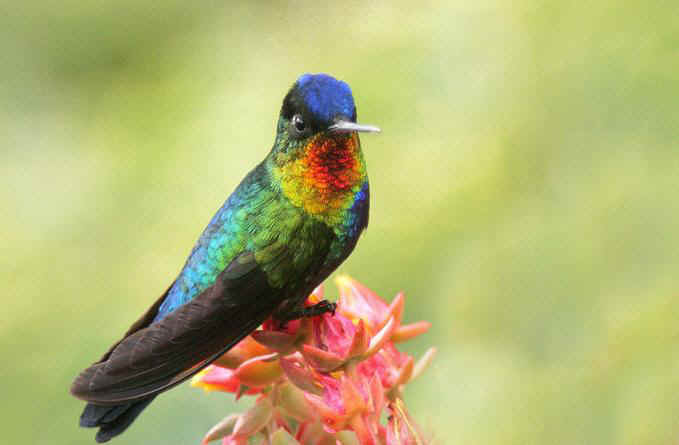
The
Fiery-throated
Hummingbird
If there's this much color on one bird,
imagine how on 6 or more of them together!
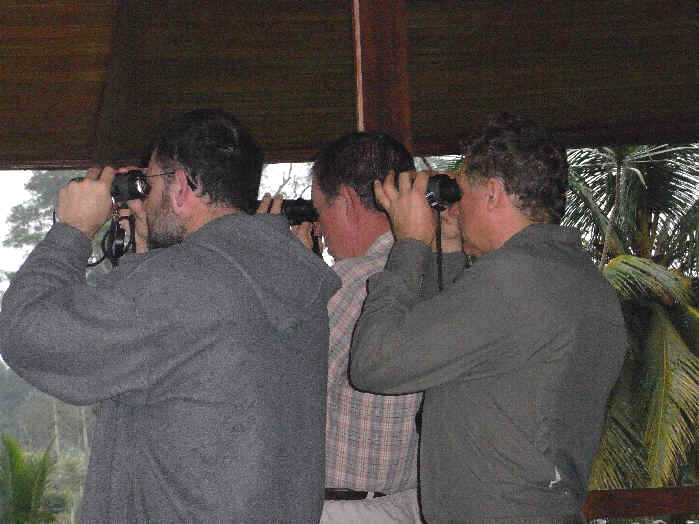
FONT tour participants birding
at breakfast
at Laguna del Lagarto, Costa Rica, in March 2010
(photo by Britta Biebach of Berlin, Germany)
Links:
More
about the FONT Costa Rica Tours in March 2010
Lists
of Birds & Other Wildlife during the FONT Costa Rica tours - March
2010
Costa Rica Birds (a list of 863 bird species; about 700 during FONT tours- with some photos)
Costa Rica Birds during northern Costa Rica tours (605 species)
Costa Rica Birds during southern Costa Rica tours (493 species)
A Photographic Sampling of Colorful Costa Rican Birds
A
Feature about Alexander Skutch, a naturalist in Costa Rica
Upcoming FONT Birding & Nature Tours in Central America
![]()
FONT E-News, Volume 20, No. 2
February 2010
from Focus On Nature Tours, Inc.
Brazil - February 2010
During this tour, in Amazonian Brazil, included a place with both Hoatzin & Harpy - Harpy Eagle, that is. It was a place in a system of Amazon waters, where we traveled mostly by boat along rivers and channels, but also where we hiked on trails in the rainforest.
Among our favorite birds were the Agami Heron and Horned Screamers, which were in addition to a good assortment of raptors, parrots and parakeets, toucans, and trogons. Small birds that were nice to see were the hummingbirds, manakins, and a tame little creature in the forest called the Dwarf Tyrant-Manakin.
But the best of our more than 200 species of birds was the Guianan Cock-of-the-Rock. Not only did we see so very well the brilliantly-colored orange males, like beacons in the forest, we enjoyed the rare sight of a dark, nearly-black, female Cock-of-the-Rock sitting on its nest, on a ledge of a big rock, at a grotto by the entrance to a cave, in which, during the day, numerous bats were roosting.
Other mammals during the tour included various monkeys: the Golden-handed Tamarins, White-bearded Sakis, Brown Capuchins, and the noisy Red Howler Monkeys. In the water, we saw both Gray Dolphins and Pink River Dolphins. The Amazonian Manatee was there also.
Among other birds (too many to note here), a few, however, should be mentioned, including: the hollering of a group of Red-throated Caracaras, along with the raucous calls of macaws, that late one afternoon, made the normally loud Mealy Amazons and Red-fan Parrots seem rather quiet by comparison.
Links:
List of Birds & Other Wildlife during the FONT Brazil Tour - February 2010
A
Complete List of the Birds of Brazil:
Part 1: Tinamous
to Flycatchers
Part 2: Antshrikes to Grosbeaks
Rare Birds during FONT Tours in Brazil (with photos)
Mammals & Other Wildlife in Brazil (with photos)
Upcoming FONT Birding & Nature Tours in Brazil
![]()
FONT E-News, Volume 20, No. 1
February 2010
from Focus on Nature Tours, Inc.
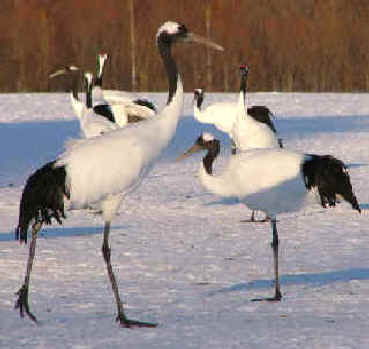
Again, on
the snow, during our January 2010 Japan Tour.
there were Red-crowned, or Japanese, Cranes,
known as "Tanchos".
The 33rd FONT birding & nature tour in Japan took place in
January 2010.
During that tour, a wild creature was seen for the first time during any of our
tours in Japan. On the northernmost Japanese island of Hokkaido, at the
easternmost place in Japan, seen from shore were 2 Sea Otters. At another place
in eastern Hokkaido, late that same day, as many as 1,000 Sika Deer were seen.
And these in that part of Japan were in addition to the avian cast of characters
that we've always enjoyed seeing, the eagles, both Steller's Sea Eagles
and
White-tailed Eagles, both seen closely, and the cranes, the Red-crowned, or Japanese,
Crane, that were again
as stately as they've always been for us, on the
snow.
Among the numerous waterfowl that we saw during the tour were 2 species of
swans, 2 species of geese, and numerous ducks. Notably beautiful among the last
of these were the Mandarin, Falcated, Long-tailed, and Harlequin
Ducks, and Smew. Of
each of these, we had wonderful sightings.
Other interesting and enjoyable sightings during the tour included: Japanese
Macaques (or "Snow Monkeys"), Pallas' Rosefinch, Red-flanked
Bluetail,
and many Daurian Redstarts and Brown Dippers.
Links:
Birds & Other Wildlife during FONT Japan Tour in January 2010
Cumulative List of Birds during our Japan Tours
Rare Birds during FONT Tours in Japan
Upcoming FONT Japan Birding & Nature Tours
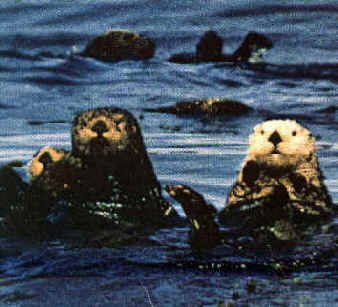
During the
FONT Japan Tour in January 2010,
2 Sea Otters, known as Rakkos, were seen
from shore in eastern Hokkaido.
The Sea Otter is very rare in Japan.
Only 2 or 3 dozen are said to exist
in the nearby islands that are part of Russia.